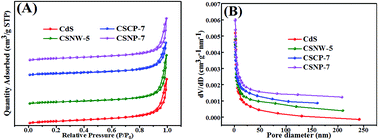CoP nanoparticles as cocatalyst modified the CdS/NiWO4 p–n heterojunction to produce hydrogen efficiently
Abstract
Generally, cocatalyst modification is an efficient way to enhance the hydrogen evolution performance of visible light irradiation. In this work, CoP nanoparticles acted as a cocatalyst to modify the CdS/NiWO4 p–n heterojunction. The composite catalyst CdS/NiWO4/CoP was successfully prepared by a co-precipitation and physical mixing method. The maximum H2 production rate of the composite catalyst was 47.7 mmol h−1 g−1, which was 11.9 times and 3.3 times that of pure CdS and CdS/NiWO4 (50 wt%), respectively, and the apparent quantum efficiency was 9.7% in a 10% lactic acid system when the wavelength was 475 nm. This excellent performance is attributed to the CoP nanoparticles, which act as electron traps to provide more active sites and benefit electron transport. Photoluminescence spectroscopy and electrochemical performance analysis demonstrated that the composite catalyst had a better electron separation ability and light absorption conversion ability. Mott–Schottky and UV-visible diffuse reflectance testing indicated that the excellent electron and hole separation was due to the p–n junction formed between CdS and NiWO4, and the modification of the CoP cocatalyst further enhanced the charge-separation efficiency, thereby improving the hydrogen evolution activity.



 Please wait while we load your content...
Please wait while we load your content...